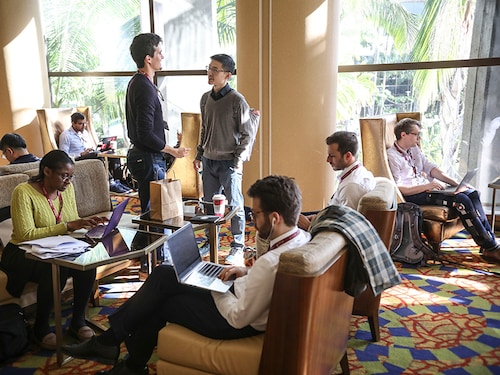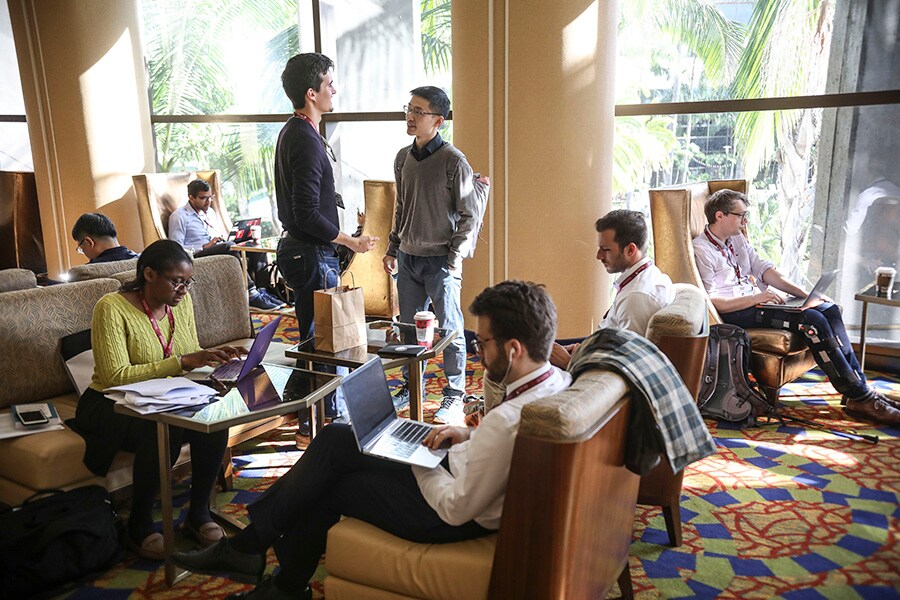For women in economics, the hostility is out in the open
Gender and racial gaps in economics are wider, and have narrowed less over time, than in many other fields


 Attendees mingle at an American Economic Association conference in San Diego on Jan. 3, 2020. New research details how men and women are treated differently when they make economic presentations. Image: Sandy Huffaker/The New York Times
Attendees mingle at an American Economic Association conference in San Diego on Jan. 3, 2020. New research details how men and women are treated differently when they make economic presentations. Image: Sandy Huffaker/The New York Times
A few years ago, economists Alicia Sasser Modestino and Justin Wolfers sat at the back of a professional conference and watched Rebecca Diamond, a rising star in their field, present her latest research on inequality. Or at least she was meant to present it — moments after she began her talk, the audience began peppering her with questions.
“She must have gotten 15 questions in the first five minutes, including, ‘Are you going to show us the data?’” Modestino recalled. It was an odd, even demeaning question — the session was in the data-heavy field of applied microeconomics. Of course she was going to show her data.
Later that morning, Modestino and Wolfers watched as another prominent economist, Arindrajit Dube, presented a paper on the minimum wage. But while that was one of the most hotly debated topics in the field, the audience allowed Dube to lay out his findings for several minutes with few interruptions.
Over a drink later, Modestino and Wolfers wondered: Had the audiences treated the two presenters differently because of their genders?
They couldn’t be sure. Maybe the audience treated Dube differently because he was more senior. Maybe they had simply found his paper more convincing, or less interesting. Maybe the observations of Modestino and Wolfers were a result of their own biases — Dube, in an email, recalled getting lots of questions, some of them quite skeptical. (He added that he didn’t know how his reception compared with Diamond’s, and he said he didn’t challenge Modestino’s recollection overall.)
So Modestino and Wolfers, who has written on economics in The New York Times, did what economists often do: They gathered data. Along with two other economists, Pascaline Dupas and Muriel Niederle, they recruited dozens of graduate students across the country to attend hundreds of economics presentations to record what happened. Their findings, according to a working paper that is expected to be published next week by the National Bureau of Economic Research: Women received 12% more questions than men, and they were more likely to get questions that were patronizing or hostile.
“It measures something that we thought couldn’t be measured,” Modestino said. “It links it to a potential reason that women are underrepresented in the profession.”
(Another sign of trouble in the profession: Modestino and her colleagues listed their graduate student contributors as co-authors on their paper, but many declined to have their names published out of fear of retaliation.)
The paper is the latest addition to a mounting body of evidence of gender discrimination in economics. Other researchers in recent years have found that women are less likely than men to be hired and promoted, and face greater barriers to getting their work published in economic journals. Those problems are not unique to economics, but there is evidence that the field has a particular problem: Gender and racial gaps in economics are wider, and have narrowed less over time, than in many other fields.
In response to those concerns, the American Economic Association commissioned a survey of more than 9,000 current and former members that asked about their experiences in the field. The results, released in 2019, revealed a disturbing number of cases of harassment and outright sexual assault. And it found that subtler forms of bias were rampant: Only 1 woman in 5 reported being “satisfied with the overall climate” in the field. Nearly 1 in 3 said they believed they had been discriminated against. And nearly half of women said they had avoided speaking at a conference or seminar because they feared harassment or disrespectful treatment.
“Half of women are saying they don’t even want to present in a seminar,” Modestino said. “We’re losing a lot of ideas that way.”
The harsh reception faced by women is particularly striking because they are also less likely to be invited to present their research in the first place. Women accounted for fewer than a quarter of the economic talks given over recent years, according to another paper. Racial minorities were even more underrepresented: Barely 1% of the speakers were Black or Hispanic.
“It’s just embarrassingly bad,” said Jennifer Doleac, an economist at Texas A&M University who is one of that study’s authors. Only about 30 talks have been delivered by Black or Latina women since the authors began tracking the data, she noted. “These scholars are just not being invited, ever.”
The lack of representation is so significant that Modestino and her colleagues could not study whether Black and Latino economists were treated differently in seminars than their white counterparts — there were too few examples in their data to analyze.
The lack of opportunities has potentially significant career consequences. Research presentations, known as seminars, are an important way that academics, particularly those early in their careers, disseminate their research, build their reputations and get feedback on their work.
Seminars play a particular role in economics. In other fields, they tend to be collegial affairs, with mostly respectful questions and few interruptions. In economics, however, they often resemble gladiatorial battles, with audience members vying to poke holes in the presenter’s argument. Seemingly every economist, regardless of gender, has at least one horror story of losing control of a presentation. Many say they have been brought to tears.
Most economists acknowledge that there are bad actors who are more interested in scoring debating points than raising legitimate questions. But many defend the field’s culture of aggressiveness, saying it is helpful to get feedback — even critical feedback — from colleagues.
“I expect a room full of economists to speak up and have their own opinions and ideas,” said Ioana Marinescu, a University of Pennsylvania economist. “To me, if they’re not asking questions, they might be a little bit zoned out.”
Marinescu recalled a talk she gave at a prestigious conference several years ago, where she, too, faced frequent interruptions. It was terrifying, she said — but also stimulating.
“The questions were incessant, but they were awesome questions from the top people in the profession,” she said. “From my perspective, it was one of the best experiences I ever had.”
Still, Marinescu said, reforms are needed.
In recent years, some economists have begun to question the field’s culture of aggressiveness, arguing that it discourages people from entering the field. Several universities have instituted rules meant to cut down on bad behavior, such as banning questions for the first 10 or 15 minutes of a talk so that speakers can get through at least the beginning of their presentations uninterrupted.
But Judith Chevalier, a Yale economist who chairs the American Economic Association’s Committee on the Status of Women in the Economics Profession, said rules intended to improve seminars would not address the underlying problems that Modestino’s research revealed.
“Seminars are a public setting — seminars are when they are on their good behavior,” Chevalier said. “We can’t declare victory even if we fix seminars. We need to reexamine everything. Are we biased when we hire? Are we biased when we mentor? Are we biased in seminars? Are we biased when we promote?”
First Published: Feb 24, 2021, 15:39
Subscribe Now